With interior design increasingly focused on style and functionality, choosing the perfect side table for your living room has become a crucial decision. These little beauties can not only add a touch of style to your space, but also provide valuable functionality. In this article, we will explore the importance of side tables in decorating a living room and guide you through the main selection criteria to enhance your living space.
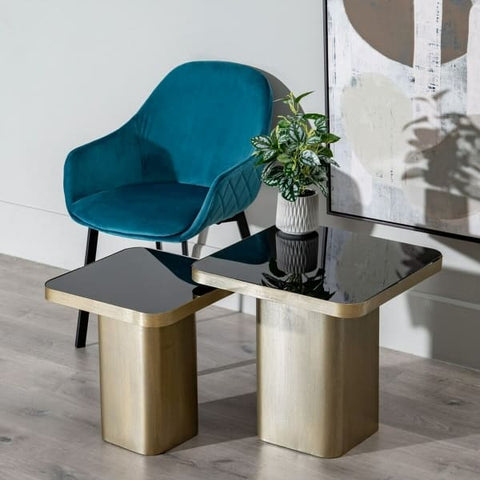
When choosing a side table, it's not just about finding a place to set a cup of coffee. This is an opportunity to make a style statement, enhance the aesthetics of your living room and add an element of functionality. Whether you're looking to complement a classic, modern, or industrial ambiance, or simply need some extra storage space, we'll show you how to make the perfect choice for your living room. Get ready to transform your space into something both beautiful and functional with the selection of the ideal side table.
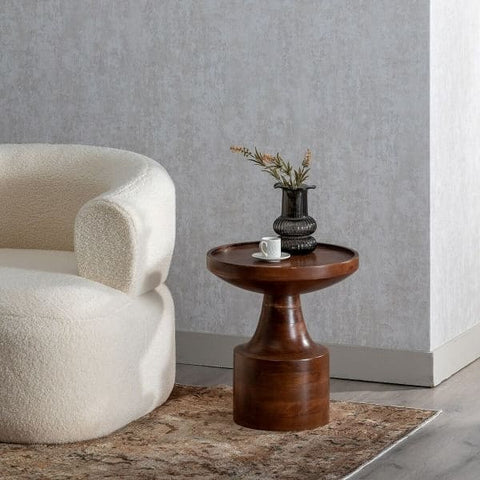
Discover our magnificent designer side tables
Understand your needs
In order to choose the perfect side table for your living room, it is essential to understand your specific needs. This first step will help guide your selection and ensure that your new table fits harmoniously into your living space.
Assessment of available space in the living room
Start by measuring and evaluating the available space in your living room. Consider the size and layout of the room, as well as where you plan to place the side table. Make sure that the table you choose fits correctly in the intended location and does not create a visual overload.
Identification of the intended uses of the side table
Side tables can have a variety of functions: serving as a holder for drinks, snacks, books, or even as a base for decoration. Determine how you plan to use the side table. If you need additional storage, consider a table with drawers or shelves. For a more decorative use, you can opt for a table with an aesthetic design.
Determining the style of decorating the living room
Your side table should fit harmoniously with the decorating style of your living room. Identify the style of your space: is it classic, modern, industrial, Scandinavian, or something else? A well-chosen side table can complement and enhance the style of your living room, whether by adding a touch of sophistication or creating a striking visual contrast.
Once you have assessed the available space, defined the intended uses and identified the style of your decor, you will be ready to explore the different side table options that will meet your needs and aesthetic preferences.
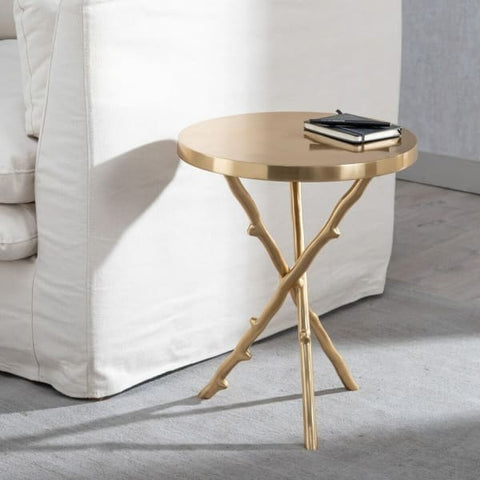
Discover our golden branches side table
Choosing the Right Material for Your Side Table
Choosing the material for your side table is a crucial decision, as it will impact its appearance, durability and ease of maintenance. Different materials are commonly used to make side tables, each with their own advantages and disadvantages. To choose which material is best for your living room, let's take a closer look at the most popular options.
Commonly used materials for side tables
-
Wood : Wooden side tables are timeless and warm. They can be made from various types of wood, such as oak, walnut, pine, teak, etc. Wood brings a touch of nature and tradition to your decoration. It is versatile and can adapt to different decoration styles.
-
Metal : Metal side tables are modern, durable and often lightweight. Aluminum, steel, and brass are popular choices. Metal offers an industrial or contemporary aesthetic, ideal for modern interiors. It is also resistant to shock and wear.
-
Glass : Glass side tables are elegant and add a touch of lightness to your space. They are ideal for small spaces because the glass allows light to circulate. However, they require regular maintenance to prevent fingerprints and scratches.
-
Mixed materials : Some side tables combine different materials, such as wood and metal, to create a unique look. These material blends often offer the best of both worlds in terms of aesthetics and durability.
Advantages and disadvantages of each material based on aesthetics and durability
-
Wood : Wood offers natural warmth and a variety of finishes, but it can be susceptible to scratches and stains. Regular maintenance is necessary to preserve its beauty.
-
Metal : Metal is durable and strong, but it can feel cold and require a cushion or covering to prevent it from being too hot or too cold to the touch.
-
Glass : Glass is sleek and visually light, but it requires special attention to avoid scratches and fingerprints.
-
Mixed materials : Mixed material side tables offer a balance between aesthetics and durability, but they can be more expensive.
The choice of material will depend on your personal style preferences, the table's intended use, how much maintenance you are willing to do, and how it coordinates with other furniture in your living room. Let's continue our exploration to help you choose the ideal side table.

Select the shape and size of your side table
Choosing the shape and size of your side table is essential to ensure that it fits harmoniously into your living room. These elements determine the functionality of the table, its aesthetics and its suitability to the space. Here are some tips to guide you in this crucial selection:
Tips for choosing a shape that complements existing furniture
-
Square or rectangular : Square or rectangular side tables are versatile and fit well with linear sofas or room corners. They offer generous storage space and are ideal for placing decorative objects, lamps or snacks.
-
Round : Round side tables add a touch of elegance to your living room. They are ideal for circular spaces, under a window or near a corner sofa. Their absence of corners makes them friendly and safe, perfect if you have young children.
-
Oval : Oval side tables combine the advantages of square and round tables. They offer a spacious surface while eliminating protruding corners. This shape is perfect for larger spaces.
-
Other specific shapes : Some side tables have more original shapes, such as hexagons, clovers, or geometric shapes. These unique pieces are ideal if you are looking for a bold decorative element.
The ideal size depending on the layout of the living room
-
Height : The height of your side table should be approximately the same level as the armrest of your sofa or armchairs. This makes the side table functional for placing objects and drinks without having to bend or stretch.
-
Width and depth : The size of the table should match the available space. It should not be too big or too small. Measure the space where you plan to place the table to get a clear idea of the appropriate dimensions.
-
Visual balance : Make sure the side table is in proportion to other furniture in the room. If your sofa is massive, opt for a medium-sized table. For a smaller space, a light and discreet table may be suitable.
By keeping these tips in mind, you can choose the shape and size of your side table in a way that makes it functional and aesthetic, while complementing the style of your living room. The next step is to explore style and design options to find the perfect table that will meet your needs.
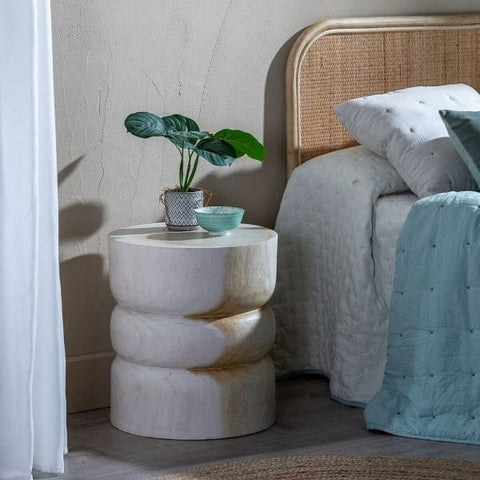
Explore Side Table Styles
Choosing the style of your side table is a crucial step in defining the atmosphere of your living room. Whether you prefer a clean, modern look, a classic, timeless design, or a trendy industrial aesthetic, there are a variety of styles to choose from. Here's a look at the most popular styles and tips for selecting the one that best matches the aesthetic of your space:
Presentation of the different styles of side tables
-
Modern : Modern style side tables feature clean lines, smooth materials like glass and metal, and neutral colors. They are ideal for contemporary and minimalist interiors.
-
Classic : Classic style side tables are timeless and elegant. They highlight noble materials such as solid wood and often feature delicate ornaments. This style suits traditional decors or spaces that emphasize sophistication.
-
Industrial : Industrial side tables are inspired by old factories and warehouses. They are made from raw materials like aged metal and recycled wood, and often feature hardware elements. This style brings unique character to any space.
-
Scandinavian : Scandinavian style side tables are simple, functional and feature light finishes, often in wood. They create a warm and friendly atmosphere, ideal for a Nordic or contemporary interior.
-
Rustic : The rustic style highlights side tables made of raw wood, often aged or recycled. They evoke an atmosphere of a mountain chalet or farm. This style is ideal for a country or vintage interior.
Tips for Selecting a Style to Match the Living Room's Overall Aesthetic
-
Coincidence with existing style : Take into account the style of furniture and decoration in your living room. Choose a side table that fits harmoniously with the aesthetic already present.
-
Color Harmony : Make sure the color of the side table matches the color scheme of your living room. A complementary or consistent color can reinforce the visual unity of the space.
-
Contrast : However, a slight contrast can also be effective. A distinctly styled side table can serve as a visual focal point or contrasting element in an otherwise cohesive space.
-
Personalization : Don't be afraid to personalize your side table by choosing details or finishes that reflect your personal taste.
By exploring the different styles of side tables and matching them to your living room aesthetic, you'll be able to choose a piece that not only fulfills its functional role, but also adds a touch of style to your space. The rest of this guide will cover aspects such as functionality, budget and purchasing your ideal side table.

Highlighting the functionality
Suggestions for maximizing the functionality of the side table
When choosing a side table, it is essential to consider its functionality. Here are some suggestions for maximizing the functionality of your side table:
-
Drawers and shelves : Select a side table that has drawers or shelves for additional storage. This will allow you to keep your living room organized by hiding small items, such as remote controls, magazines or books.
-
Nesting Tables : Nesting side tables offer exceptional versatility. You can use them as one large table or separate them to create multiple accent surfaces. This comes in particularly handy when entertaining or when you need extra space.
-
Table with Removable Top : A side table with a removable top can serve as a lunch tray, laptop tray, or holder for your drinks. It is ideal for moments of relaxation in the living room.
-
Convertible table : For smaller spaces, consider a convertible side table that can transform into a coffee table or accent desk as needed. This option is ideal for optimizing space.
Tips for integrating the side table into the needs of the living room
-
Storage space : If you are short on storage space in your living room, choose a side table with drawers, shelves or storage compartments. This will allow you to hide everyday objects and keep your living room tidy.
-
Lighting point : You can integrate accent lighting into your side table. Choose a stylish table lamp or side table with a hollow base to place candles. This creates a warm ambiance in your space.
-
Multifunctional table : For compact spaces, choose a multifunctional side table that can serve as a nightstand, an occasional desk, or a table for meals in front of the TV.
-
Decorative accent : Your side table can also be a decorative element in its own right. Place decorative items such as vases, photo frames, or houseplants to personalize the space.
When considering the functionality of your side table, make sure it meets your specific needs and fits harmoniously into the style of your living room. A well-chosen side table can be a valuable asset to your living space.
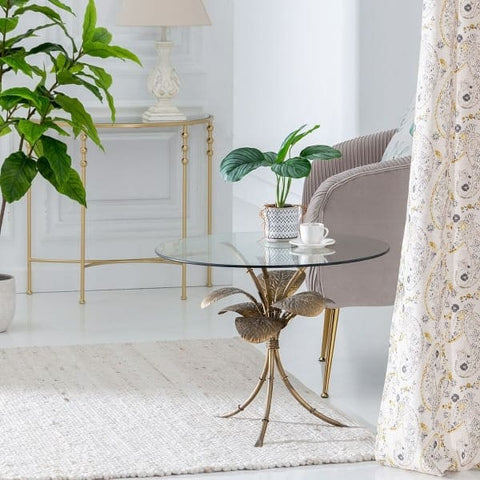
Harmonize with the decoration
Ideas for matching the side table with existing decorative elements
Harmonizing your side table with the decoration of your living room is essential to create a coherent atmosphere. Here are some ideas for matching your side table with existing decorative elements:
-
Complementary colors : Choose a side table whose color complements or contrasts harmoniously with the color palette of your living room. For example, if your living room is dominated by neutral tones, choose a brightly colored side table to create a visual focal point.
-
Matching Patterns : If your decor features patterns, try choosing a side table with similar or complementary patterns. Make sure there are not too many patterns to avoid visual overload.
-
Furniture style : The style of your side table should be in keeping with the overall style of your furniture. For example, a side table with a minimalist design is perfect for a modern interior, while a distressed wood table fits well into a rustic decor.
-
Matching Materials : Make sure the materials of your side table blend well with the materials of your other furniture. If you have a leather sofa, a black metal table can create a stylish contrast.
Examples of successful combinations
-
Contemporary minimalism : In a contemporary style living room with a light gray sofa and white walls, a tempered glass and chrome metal side table adds a touch of sophistication while maintaining simplicity.
-
Bohemian vibe : For a bohemian living room with bright colors and ethnic textiles, a raw wood side table and carved details harmonize perfectly, adding a touch of authenticity.
-
Timeless classic : In a classic-style living room with upholstered furniture and neutral tones, a white marble and gold metal side table lends timeless elegance.
-
Urban industrial : For an industrial style interior with black steel elements and exposed bricks, a side table in reclaimed wood and black metal reinforces the robust appearance of the decoration.
By choosing a side table that harmonizes with existing decorative elements, you will create a visually coherent and pleasant ensemble. The side table can thus become an essential element of your interior decoration.

Selecting the Perfect Side Table
After exploring the different steps to choose the perfect side table, it is essential to remember the key criteria that will guide you in your choice. In summary, here are the points to consider:
-
Understand your needs : Evaluate the space available in your living room, identify the intended uses of the side table and determine the style of decoration that suits you.
-
Choosing the Right Material : Consider the pros and cons of commonly used materials for side tables (wood, metal, glass, etc.) based on aesthetics and durability.
-
Select shape and size : Choose a shape that complements existing furniture and consider the ideal size based on the layout of your living room.
-
Explore side table styles : Familiarize yourself with the different styles available (modern, classic, industrial, etc.) and choose the one that best suits the aesthetic of your space.
-
Highlighting functionality : Look for options that maximize the functionality of the side table, such as drawers or shelves, taking into account your specific needs.
-
Harmonize with the decoration : Match the side table to existing decorative elements by playing with colors, patterns, style and materials.
Remember that the side table is much more than just a piece of furniture. It can be a key element of your interior design, adding both functionality and aesthetics to your space. By investing time and thought into your choice, you are well on your way to finding the perfect side table that will add a unique touch to your living room.

The keys to choosing the perfect side table
At the end of our exploration to choose a side table that will highlight your living room, we can summarize the main steps to remember:
-
Understand your needs : Evaluate the available space, identify the intended uses and harmonize the style of your living room.
-
Choosing the Right Material : Consider the pros and cons of materials based on aesthetics and durability.
-
Select the shape and size : Choose a shape that matches the furniture and a size suited to your configuration.
-
Explore styles : Familiarize yourself with the different styles available and choose the one that matches your decor.
-
Feature enhancement : Look for options that meet your specific needs.
-
Harmonize with the decoration : Match the table with existing elements to create a cohesive atmosphere.
Let your creativity flow
When it comes to interior design, every detail counts. The side table is not only a functional piece of furniture, but a design element that can transform your living room. Explore the countless options available on the market and make your choice a reflection of your personal style.
Don't be afraid to mix materials, play with colors, or opt for bold shapes. Your side table can be a focal point or a subtle addition, but it should always embody your creative vision.
The Tendances Meubles team.
